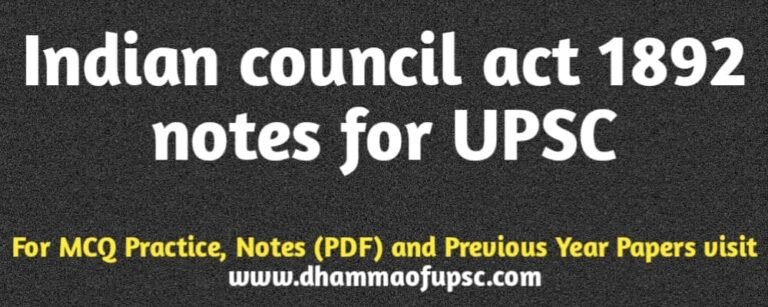Indian council act 1892 UPSC short notes

Here we will study the Indian council act 1892 (UPSC) from the viewpoint of Civil services exam and other State PSC exams. British Parliament passed this act in 1892. The most important point of this act was that it increased the number of non official members in Central and Provincial Legislative Council.
Here we will cover the important features of Indian council act 1892 which will be useful for your UPSC exams and other State PSC exams.
For topic wise complete Indian Polity video lectures- Click Here
For UPSC video lectures you can subscribe our YouTube channel also. Subscribe Here
Why the Indian council act 1892 was passed?-
As we know in 1885 Indian National Congress was founded. Indian National Congress demanded that legislative councils should be expanded and reformed. In response to these demands, British Parliament enacted Indian Council Act 1892.
Main features of Indian council act 1892 (UPSC)-
The Indian council act 1892 (UPSC) continued the process of associating Indians with law making process which was started in Indian council act 1861. The viceroy during Indian council act 1892 was Lord Landsowne. Now let’s study the salient features of the Indian council act 1892.
Salient features of Indian council act 1892-
Some of the salient features of Indian council act 1892 are-
- It increased the number of non official members in Central and Provincial Legislative council but it maintained official majority in the councils at both central and provincial level.
- It increased the functions of Legislative council and gave them the power of discussing budget and asking questions to the Executive but members could only ask these questions on matters of public interest after giving 6 days notice.
It provided Viceroy the powers to nominate some non official members to Central legislative council but he could nominate these members only on the recommendation of Provincial legislative council and Bengal Chamber of Commerce.
Governors of Provinces could also nominate some non official members to provincial legislative council but he could only do so on the recommendation of district boards, municipality, universities, trade associations, zamindars and Chambers of Commerce.
It made a limited and indirect provision for the use of election in filling up some of the non-official seats in both Central and Provincial Legislative Council, but the word election was avoided in this the process.
Drawbacks of Indian Council act 1892–
There were several drawbacks in Indian council act 1892. lets discuss them-
- It still maintained official majority in the central and provincial legislative council.
- Indians, though represented in the council as non official members were still in minority in the councils.
- This act provided only half hearted representation to Indians.
- Deliberative functions of councils was still limited.
- Members could only discuss budget, not vote upon it.
These are the Main features and drawbacks of Indian council act 1892. These points are very important from the viewpoint of our UPSC and other state PSC exams.
Have a Glance-
To Further enhance your UPSC exam preparation and take it to the next level, go through these direct links given below.
- For Topic wise free UPSC MCQ questions practice sets of UPSC exam- Click here
- For Topic wise crisp UPSC notes (free UPSC material) of UPSC exam- Click here


